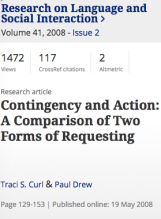Readers of the journal will often see Conversation Analysis applied to real-world problems, and in this guest blog, Lisa Mikesell reports on her work with patients with dementia. The full story is in her article in the current issue, and here she asks how caregivers manage the delicate task of monitoring patients’ actions – and on occasion, correcting them when things go wrong.

Lisa Mikesell, Rutgers University
I often work closely with clinicians, from neurologists to psychiatrists. I take a keen interest in how communicative and social behaviors are typically measured, and what those measures end up meaning clinically and practically to both providers and patients.
Behavioral variant frontotemporal dementia (FTD) is one such example. FTD is a young-onset neurodegenerative dementia, in which basic cognition is relatively preserved in early stages – but social behavior, personal and interpersonal conduct, are markedly impacted. That makes it particularly interesting to understand from an ecologically grounded perspective such as Conversation Analysis.
How can Conversation Analysis help?
So for the last several years, I have used been using CA to examine everyday functioning in this kind of dementia, particularly with the aim to better understand the relationship between formalized measures of social behavior and what individuals are actually doing in the real world. It was this interest that motivated my look into interactional repair and moments when caregivers’ guide individuals’ participation in a range of activities. While my previous work tended to focus on the trouble sources targeted by repair (and what it says about the diagnosed individual), this new paper focuses on the repair initiator and repair sequence (and what it reveals about the practical challenges of caregiving). (And here I would like to express my thanks to the insightful suggestions of the ROLSI reviewers who helped me down this path).
Co-ordination between caregivers and patient
Much of the data is activity-centered with caregivers coordinating – initiating and guiding – tasks like playing games, shopping, making meals. This guidance is often accomplished with directives that identify an individual’s participation as inappropriate and in need of altering. In these activity contexts, the formats of caregivers’ directives often make compliance the relevant next action, and thus gloss the perceived impaired status of individuals. However, their directives also seem to be motivated by the necessity and urgency of some alternative engagement to successfully accomplish a task.
Maintaining progressivity
 Activities that required a particular kind of engagement and required it quickly to maintain progressivity of the activity were often repaired with imperatives – or, in Curl and Drew’s (2008 )terms, high entitlement, low contingency (HE/LC) directives.
Activities that required a particular kind of engagement and required it quickly to maintain progressivity of the activity were often repaired with imperatives – or, in Curl and Drew’s (2008 )terms, high entitlement, low contingency (HE/LC) directives.
For example, here ET and Steve have agreed to enact the comics with each responsible for a particular character. After ET directs the pre-activity arrangements (lines 1-15) to which Steve aligns, Steve is to enact his character but remains looking silently at the newspaper (the trouble source, TS). CT and ET then repair using imperative forms.

Repair using imperative, line 20
Such HE/LC directives explicitly identify the TS and often articulate the next action required for activity progression. On the other end of the activity spectrum are activities whose successful accomplishment does not require a particular kind of engagement or require urgent participation to accomplish. During these activities, caregivers are more likely to redirect participation using weaker, more mitigated directive formats.
Dealing with trouble
Below while ET and Robert are making lunch, Robert leaves the water running and ET initiates repair, not by producing a strong imperative form that makes relevant compliance as the next action (thus maintaining progressivity of the lunch activity underway), but by asking a “why” question (line 4), which makes relevant an explanation or account. Although this multi-turn repair sequence derails the lunch activity perhaps more extensively than simply directing Robert to “turn off the water,” his immediate compliance here may be less crucial to the focal activity, given there is no urgency or particularity with which lunch must happen.

Asking a pointed question, line 4
In the middle of the activity spectrum are ones in which a particular type of participation is not essential or urgent for activity completion but one’s engagement is nevertheless treated as inappropriate but not urgent or essential, for instance, as ill-timed in the activity’s progress. In these cases, we see a variety of mitigated directive forms including accounts and descriptions of (non)desired actions (“you’re jumping ahead”;“we’re sitting up”).
Directives when urgent
In sum, for well-defined activities requiring a particular kind of engagement to happen quickly, HE/LC directives seem to be the preferred format, illustrating not only caregivers’ orientations to their rights to direct those in their care but perhaps also their sensitivity to the disruption of the progressivity of the activity, often producing the “quickest” fix. Caregivers of individuals diagnosed with FTD face a number of unique challenges different from caregivers of other dementias. This paper hoped to provide a glimpse into how they manage everyday tasks by redirecting the participation of those in their care.
Reference:
Mikesell, L. (2016). The Use of Directives to Repair Embodied (Mis) Understandings in Interactions with Individuals Diagnosed with Frontotemporal Dementia. Research on Language and Social Interaction, 1-19.
